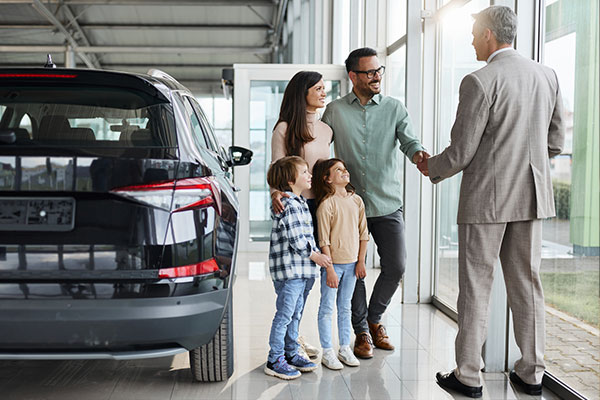
How to Decide if it’s Time to Buy a New Car
You’ve been driving your car for years and it’s showing some wear and tear. Maybe it gets terrible gas mileage or lacks the latest technology and safety features. On the other hand, you’ve probably paid it off and would prefer not to make the monthly payments that come with trading up. Buying a new car is a major financial decision, so before you start shopping around, weigh the pros and cons and think carefully about what you can afford. Farmers State Bank can help you understand your options and determine whether a new car, used car or lease is right for you, or if you’re better off sticking it out and waiting a little longer.
Weigh Your Options
The decision to buy a new car vs. keep the one you’re driving comes down to a cost-benefit analysis. Most cars on the road today are about 12 years old, and the general rule of thumb is to drive a car until it clocks 200,000 miles, provided you can afford the cost of maintenance and repair. Ask yourself the following questions as you begin your search:
- Why do I want a new car?
- How many miles are on my current vehicle, and are they from mostly highway driving or local/city driving?
- How much does it cost to maintain the car I’m driving now, including insurance?
- Have I paid off my current car loan?
- Is my car safe and reliable, or is it often in the shop?
- Does my current car work for my lifestyle?
- Can I afford a new vehicle?
All these factors play a part in your decision, but finances are probably most important to you. If the amount of money you’re spending to keep your current vehicle on the road is approaching the monthly payment for a new one, it may be time for an upgrade. Cars require more frequent maintenance as they age, so the cost will generally increase over time.
Begin by estimating the total cost of a new vehicle and compare it to the amount of money you’re spending to maintain your current car. Bear in mind that the cost of a new car goes beyond monthly loan payments—you’ll have to account for interest, insurance, taxes, registration fees, depreciation and other expenses. Expect to allocate about 15% of your family budget to buying and maintaining a new car and be sure to choose a vehicle that doesn’t exceed this threshold. You should also examine any other debt you’re carrying, like a home mortgage or personal loan.
Note that your total family debt should never exceed 36% of your collective take-home pay. To get better insight on your debt, find out how much you owe and how long it will take to pay it all off with this Managing Debt Calculator. Also consider that in Indiana, the average cost of car ownership over five years is $26,540.
When to Buy a New Car in Indiana
If your current vehicle is nearing the end of its lifespan, it’s time to begin thinking about a new car. New cars can offer better gas mileage and fuel economy, improved safety and convenience features, warranty coverage and added reliability.
Determine your annual car budget and compare it to what you’re spending on your current vehicle. What percentage of your total car budget are you spending to maintain the one you have now? What percentage are you comfortable spending? This is a personal choice and can depend on how much life you estimate is left in your current car. If maintenance costs approach 50% of your total car budget, for example, you may decide it’s time for something new. Use our budget calculator to determine how much you can comfortably contribute to a new car, then weigh that against the cost to maintain your current vehicle.
You may also opt for a new car if your lifestyle has changed since you purchased your last one. If you’ve moved from the suburbs to the city and street parking is tight, an SUV or truck might be impractical. Perhaps you’ve relocated somewhere snowy and need four-wheel drive to stay safe in the winter. You may have changed jobs or neighborhoods, increasing your commute, so you want a car with better gas mileage.
While status symbol may also be a consideration, appearances are often a nice-to-have and should never trump your budget. If you simply can’t afford a new car, wait until you can, or consider leasing or buying a used vehicle instead.
Have you paid off your current vehicle? You should only consider buying a car if you’ve settled up your current loan. If you haven’t, you’ll either need to pay it off or roll it into your new car loan, which could add hundreds to your monthly payment. You may also find that your current car has depreciated such that its market value is less than what you owe, so it’s smart to make any remaining payments before trying to sell it or trade it in. Kelley Blue Book is a great reference to estimate the value of your current car.
When to Buy a Used Car
If your current vehicle is bleeding your bank account but you can’t afford a new car, a well-maintained used car can be a great alternative. You can often find good deals on used cars coming off leases. Mileage tends to be low, and the dealer will have addressed any maintenance or repair work before listing the vehicle. Bear in mind, however, that more significant repairs will contribute to the list price, so try to find a car that went back to the dealer in good shape. If you have a specific vehicle in mind, you can look up its maintenance history on CARFAX.
New cars also depreciate rapidly, so buying used with lower mileage usually gives you more bang for your buck. Used cars tend to retain more of their value, since depreciation is most significant over the first few years of a vehicle’s lifespan. New cars typically lose about 20% of their value in the first year of ownership and an additional 10% over each of the next four years, according to CARFAX. Depreciation tapers off over time, so the longer you plan to keep your car, the less it will impact you financially.
When to Consider a Lease
Leasing a new car can be a great option if you can’t afford to purchase outright but your current vehicle is outdated, unsafe or expensive to maintain. You may also consider a lease if you aren’t ready or able to commit to 10+ years in a single vehicle, or if you’re planning imminent lifestyle changes that would require a different kind of car.
There are two main factors at play when considering a lease. When you lease a car, you have no equity in the vehicle. This is like renting vs. buying a home. Paying rent gives you access to your home for a designated period of time and provides you with flexibility to move at the end of your lease. When you pay a mortgage, on the other hand, that money goes back into your pocket if you decide to sell the house. Leasing vs. buying a car works similarly but be aware that the value of a home can appreciate, while a car’s value will decline as the years and miles go by.
Leasing also works best if you can stay within the allowed mileage. Typically, leased cars come with annual mileage limits of 10,000 to 15,000. If your commute is relatively short and you only drive locally, you should have no trouble staying under the limit. If, on the other hand, you have a long commute or take regular road trips, you’ll want to be cognizant of this. Exceeding your allowed mileage will incur penalties, which vary depending on the car but come in at an average of $0.25 per mile, according to Autotrader. Any penalties will be paid at the end of your lease, include mileage overages and cleaning or repair costs.
You can offset these penalties by buying the vehicle when your lease is up. This is like getting a good deal on a used car and can be a viable option if you can see yourself driving the vehicle for years to come. Note that your lease payments will be applied to the purchase price, so you’ll pay less than you would to buy a comparable new or used car.
When to Keep Your Current Car
While a new car may be appealing, keeping your current vehicle is almost always the smartest financial move, provided the car is safe and reliable. Estimate the amount of money you’ve spent on maintenance for your current vehicle over the past year. If the cost of maintenance and repair is lower than your expected monthly payment for a new car, it makes the most financial sense to keep the one you have. If your current vehicle is a gas guzzler, a new car might save you money on fuel, but you’ll have to run the numbers to determine whether these savings would offset the cost of a new car.
Why do you want a new car? List the reasons and be honest with yourself. If it’s a matter of personal preference and nice-to-have features, carefully weigh the pros and cons and perform a cost-benefit analysis. Buying a new car is a big financial step, and you should be absolutely sure you can afford it. You should also be prepared to get pennies back for your current car, should you choose to sell it or trade it in. While this can help bring down your total out-of-pocket expense, be prepared for its value to be less than you hope.
How to Estimate Your Monthly Payments
If you’ve weighed the options and decided a new car is right for you, calculate your expected monthly payments to help determine which make and model to buy. The purchase price is just one of many factors that contribute to your total out-of-pocket cost. Interest rates are also important to consider. The interest rate on your car loan depends on a number of variables, including current national rates and your credit history. A higher credit score and longer history can help you qualify for a better rate. The average credit score for new car financing in 2019 was 715, while the average score for used car financing was 662, according to Experian.
You can access your credit information for free through Turbo, Credit Karma and similar services. You can also receive a free credit report once a year through annualcreditreport.com, which won’t harm your credit score. Credit bureaus such as TransUnion, Experian and Equifax provide free credit reports as well.
If you have weighed your options and are in the market for a car and need a car loan, Farmers State Bank can help you navigate this process. Contact us now.

Saving Time and Money
Works like a check only it’s faster, easier and more convenient.
Farmers State Bank debit cards give you quick and easy access to your funds when you need it.
